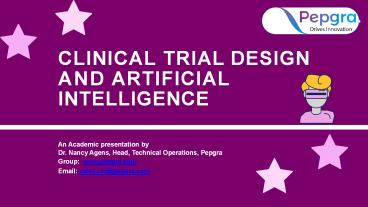Clinical Trial Design and Artificial Intelligence | Pepgra.com - PowerPoint PPT Presentation
Title:
Clinical Trial Design and Artificial Intelligence | Pepgra.com
Description:
Clinical trials take up the last half of the 10 – 15 year, 1.5 – 2.0 billion USD, cycle of development just for introducing a new drug within a market. 1. AI and its Evolution 2. AI in Clinical Trials To Continue Reading: Contact Us: Website : Email us: sales.cro@pepgra.com Whatsapp: +91 9884350006 – PowerPoint PPT presentation
Number of Views:465
Title: Clinical Trial Design and Artificial Intelligence | Pepgra.com
1
CLINICAL TRIAL DESIGN
- AND ARTIFICIAL INTELLIGENCE
An Academic presentation by Dr. Nancy Agens,
Head, Technical Operations, Pepgra
Group www.pepgra.com Email sales.cro_at_pepgra.com
2
Today's Discussion
OUTLINE OF TOPICS Introduction Factors Causing
Failures in Clinical Trials and How AI Can
Help AI and its Evolution AI in Clinical Trials
3
Introduction
Clinical trials take up the last half of the 10
15 year, 1.5 2.0 billion USD, cycle of
development just for introducing a new drug
within a market. Therefore, any clinical trials
services that end in failure tends to translate
not just in losses in terms of investment for
the clinical trial but also takes into its ambit
the costs incurred as preclinical development
costs. This renders the loss for every failed
clinical trial at 800 million to 1.5 billion
USD. It would be beneficial to explore how
Artificial Intelligence or AI as it is popularly
known can be effectively utilized to re-mould
the key phases of a clinical trial design with a
view to augment the rate of success in the
trial. Contd..
4
Figure 1 Pharma Drug Development Cycle
5
Factors Causing Failures in Clinical Trials and
How AI Can Help
- The main two factors that lead to failure within
clinical trials services pertains to the
selection of patient cohorts and the mechanisms
used for recruiting cohorts. - The said two factors are not enough to bring in
the most appropriate patients to the trial in a
timely manner, along with the absence of a
technical infrastructure. - This is particularly true in phases that come
later particularly, where there is a lack of an
effective and reliable protocol for adherence,
clinical endpoint detection systems and patient
monitoring, - Natural language processing (NLP) as well as
Human Machine Interfaces (HMIs) enables a
seamless transfer of information amongst humans
and computers.
6
AI and its Evolution
AI in the domain of medicine has a history which
goes back to the early 1970s when proficient
systems such as MYCIN had been initially
introduced for providing support to diagnostic
decisions. Early systems of medical AI depended
largely on experts from the medical domain for
training computers by encrypting clinical
knowledge as logic based rules for particular
situations or scenarios. The medical domain was
slow in terms of adapting such systems mainly
owing to the absence of data that was
extensively available. The domain of AI as such
experienced transformational developments,
especially in deep learning and machine learning
techniques.
7
AI in Clinical Trials
The figure below envisions the key techniques
through which AI can be introduced within the
tenets of clinical design. There are three key
themes within the design which comprises of
cohort composition, patient recruitment and
patient monitoring. These are founded on the
features of the patient in terms of eligibility,
suitability, empowerment, enrollment and
motivation. This is also inclusive of aspects
pertaining to trial such as adherence control,
endpoint detection and retention of
patients. Contd..
8
Figure 2 AI for Clinical Trial Design
9
Contact Us
UNITED KINGDOM 44- 7424810299 INDIA 91-98843500
06 EMAIL sales.cro_at_pepgra.com

